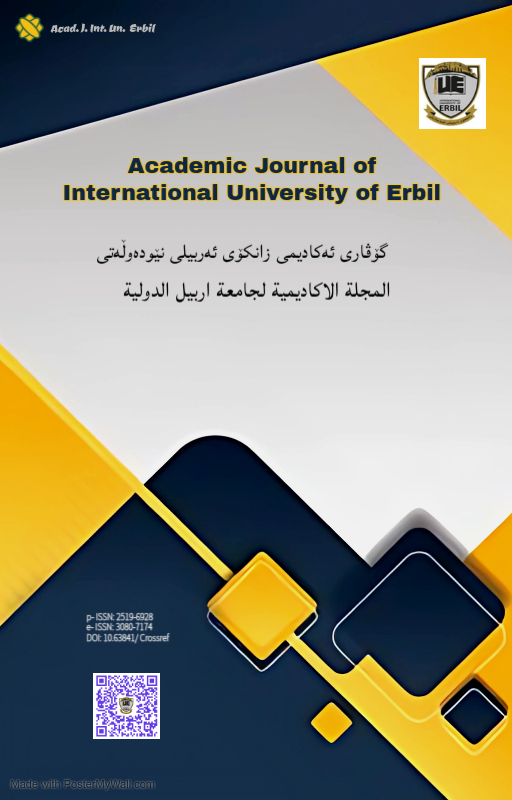Elevated Blood Cardio-Markers and its Relation to Diabetes Duration in T2DM Patients
Cardio-Markers and its Relation to Diabetes Duration in T2DM Patients
DOI:
https://doi.org/10.63841/iue24515Keywords:
Type 2 Diabetes, Cardiac Biomarkers, Hyperglycemia, Cardiovascular Risk, Troponin I, CK-MB, MyoglobinAbstract
The relationship between diabetes mellitus type 2 and cardiovascular complications stands as a primary cause of patient morbidity and mortality. The myocardial remodeling process caused by hyperglycemia leads to chronic changes which can be identified through specific cardiac biomarkers. The research investigated changes in type 2 diabetic patients regarding cardiac function biomarkers together with their relationship to disease duration and patient age and sex.
The research employed a cross-sectional design at Shahid Dr. Khalid Teaching Hospital located in Koya, Erbil. The research included 90 participants where 60 subjects had diabetes while 30 participants served as controls. The research team measured serum random blood sugar together with lipid profiles and cardiac markers Troponin I and CK-MB and Myoglobin. The analysis between groups and diabetes duration was performed through SPSS version 27.
The cardiac biomarker and lipid abnormality levels in diabetic patients exceeded those of controls at a statistical significance of p < 0.05. Patients with diabetes duration exceeding five years demonstrated worse blood sugar management and higher cholesterol levels. Diabetic patients showed elevated levels of Troponin I and CK-MB and myoglobin which indicated subclinical myocardial injury. The triglyceride and LDL and VLDL levels were elevated in diabetic patients, but HDL levels showed no significant differences.
The second form of diabetes mellitus produces significant changes in cardiac biomarkers which indicate early myocardial stress and elevated cardiovascular risk. The combination of inadequate blood sugar management with extended disease duration intensifies these effects which demonstrates the necessity for ongoing cardiac evaluations and strict metabolic management in diabetic patients.
References
R. Goyal, M. Singhal, and I. Jialal, ‘Type 2 Diabetes’, in StatPearls, Treasure Island (FL): StatPearls Publishing, 2025. Accessed: Apr. 19, 2025. [Online]. Available: http://www.ncbi.nlm.nih.gov/books/NBK513253/
T. R. Einarson, A. Acs, C. Ludwig, and U. H. Panton, ‘Prevalence of cardiovascular disease in type 2 diabetes: a systematic literature review of scientific evidence from across the world in 2007–2017’, Cardiovasc. Diabetol., vol. 17, no. 1, p. 83, Dec. 2018, doi: 10.1186/s12933-018-0728-6.
N. H. Siam, N. N. Snigdha, N. Tabasumma, and I. Parvin, ‘Diabetes Mellitus and Cardiovascular Disease: Exploring Epidemiology, Pathophysiology, and Treatment Strategies’, Rev. Cardiovasc. Med., vol. 25, no. 12, Art. no. 12, Dec. 2024, doi: 10.31083/j.rcm2512436.
T. Salvatore et al., ‘The Diabetic Cardiomyopathy: The Contributing Pathophysiological Mechanisms’, Front. Med., vol. 8, p. 695792, Jun. 2021, doi: 10.3389/fmed.2021.695792.
J. Chen, D. Yin, and K. Dou, ‘Intensified glycemic control by HbA1c for patients with coronary heart disease and Type 2 diabetes: a review of findings and conclusions’, Cardiovasc. Diabetol., vol. 22, no. 1, p. 146, Jun. 2023, doi: 10.1186/s12933-023-01875-8.
J. Yang et al., ‘Fasting Blood Glucose and HbA1c Correlate With Severity of Coronary Artery Disease in Elective PCI Patients With HbA1c 5.7% to 6.4’, Angiology, vol. 71, no. 2, pp. 167–174, Feb. 2020, doi: 10.1177/0003319719887655.
X.-Y. Wang, F. Zhang, C. Zhang, L.-R. Zheng, and J. Yang, ‘The Biomarkers for Acute Myocardial Infarction and Heart Failure’, BioMed Res. Int., vol. 2020, p. 2018035, Jan. 2020, doi: 10.1155/2020/2018035.
A. R. Gosmanov, E. O. Gosmanova, and A. E. Kitabchi, ‘Hyperglycemic Crises: Diabetic Ketoacidosis and Hyperglycemic Hyperosmolar State’, in Endotext, K. R. Feingold, S. F. Ahmed, B. Anawalt, M. R. Blackman, A. Boyce, G. Chrousos, E. Corpas, W. W. de Herder, K. Dhatariya, K. Dungan, J. Hofland, S. Kalra, G. Kaltsas, N. Kapoor, C. Koch, P. Kopp, M. Korbonits, C. S. Kovacs, W. Kuohung, B. Laferrère, M. Levy, E. A. McGee, R. McLachlan, R. Muzumdar, J. Purnell, R. Rey, R. Sahay, A. S. Shah, F. Singer, M. A. Sperling, C. A. Stratakis, D. L. Trence, and D. P. Wilson, Eds., South Dartmouth (MA): MDText.com, Inc., 2021. Accessed: Apr. 19, 2025. [Online]. Available: http://www.ncbi.nlm.nih.gov/books/NBK279052/
G. E. Umpierrez et al., ‘Hyperglycaemic crises in adults with diabetes: a consensus report’, Diabetologia, vol. 67, no. 8, pp. 1455–1479, Aug. 2024, doi: 10.1007/s00125-024-06183-8.
A. Chauin, ‘The Main Causes and Mechanisms of Increase in Cardiac Troponin Concentrations Other Than Acute Myocardial Infarction (Part 1): Physical Exertion, Inflammatory Heart Disease, Pulmonary Embolism, Renal Failure, Sepsis’, Vasc. Health Risk Manag., vol. 17, pp. 601–617, Sep. 2021, doi: 10.2147/VHRM.S327661.
A. Taghdiri, ‘Cardiovascular biomarkers: exploring troponin and BNP applications in conditions related to carbon monoxide exposure’, Egypt. Heart J., vol. 76, no. 1, p. 9, Jan. 2024, doi: 10.1186/s43044-024-00446-w.
Y. Fan et al., ‘Primordial Drivers of Diabetes Heart Disease: Comprehensive Insights into Insulin Resistance’, Diabetes Metab. J., vol. 48, no. 1, pp. 19–36, Jan. 2024, doi: 10.4093/dmj.2023.0110.
W. Widiarti, P. B. T. Saputra, C. G. Savitri, J. N. E. Putranto, and F. F. Alkaff, ‘The impact of cardiovascular drugs on hyperglycemia and diabetes: a review of ‘unspoken’ side effects’, Hellenic J. Cardiol., p. S1109966624002082, Oct. 2024, doi: 10.1016/j.hjc.2024.09.007.
E. P. Odum and E. E. Young, ‘Elevated cardiac troponin I, creatine kinase and myoglobin and their relationship with cardiovascular risk factors in patients with type 2 diabetes’, Diabetes Metab. Syndr. Clin. Res. Rev., vol. 12, no. 2, pp. 141–145, Apr. 2018, doi: 10.1016/j.dsx.2017.12.001.
Y. Li et al., ‘Diabetic vascular diseases: molecular mechanisms and therapeutic strategies’, Signal Transduct. Target. Ther., vol. 8, no. 1, p. 152, Apr. 2023, doi: 10.1038/s41392-023-01400-z.
A. V. Poznyak, L. Litvinova, P. Poggio, V. N. Sukhorukov, and A. N. Orekhov, ‘Effect of Glucose Levels on Cardiovascular Risk’, Cells, vol. 11, no. 19, p. 3034, Sep. 2022, doi: 10.3390/cells11193034.
A. Caturano et al., ‘Oxidative Stress and Cardiovascular Complications in Type 2 Diabetes: From Pathophysiology to Lifestyle Modifications’, Antioxidants, vol. 14, no. 1, p. 72, Jan. 2025, doi: 10.3390/antiox14010072.
P. González, P. Lozano, G. Ros, and F. Solano, ‘Hyperglycemia and Oxidative Stress: An Integral, Updated and Critical Overview of Their Metabolic Interconnections’, Int. J. Mol. Sci., vol. 24, no. 11, p. 9352, May 2023, doi: 10.3390/ijms24119352.
M. Wang, Y. Li, S. Li, and J. Lv, ‘Endothelial Dysfunction and Diabetic Cardiomyopathy’, Front. Endocrinol., vol. 13, p. 851941, Apr. 2022, doi: 10.3389/fendo.2022.851941.
S. Chakraborty, A. Verma, R. Garg, J. Singh, and H. Verma, ‘Cardiometabolic Risk Factors Associated With Type 2 Diabetes Mellitus: A Mechanistic Insight’, Clin. Med. Insights Endocrinol. Diabetes, vol. 16, p. 11795514231220780, Jan. 2023, doi: 10.1177/11795514231220780.
A. R. Gosmanov, E. O. Gosmanova, and A. E. Kitabchi, ‘Hyperglycemic Crises: Diabetic Ketoacidosis and Hyperglycemic Hyperosmolar State’, in Endotext, K. R. Feingold, S. F. Ahmed, B. Anawalt, M. R. Blackman, A. Boyce, G. Chrousos, E. Corpas, W. W. de Herder, K. Dhatariya, K. Dungan, J. Hofland, S. Kalra, G. Kaltsas, N. Kapoor, C. Koch, P. Kopp, M. Korbonits, C. S. Kovacs, W. Kuohung, B. Laferrère, M. Levy, E. A. McGee, R. McLachlan, R. Muzumdar, J. Purnell, R. Rey, R. Sahay, A. S. Shah, F. Singer, M. A. Sperling, C. A. Stratakis, D. L. Trence, and D. P. Wilson, Eds., South Dartmouth (MA): MDText.com, Inc., 2000. Accessed: Apr. 26, 2025. [Online]. Available: http://www.ncbi.nlm.nih.gov/books/NBK279052/
E. M. Hassan et al., ‘Overlap of diabetic ketoacidosis and hyperosmolar hyperglycemic state’, World J. Clin. Cases, vol. 10, no. 32, pp. 11702–11711, Nov. 2022, doi: 10.12998/wjcc.v10.i32.11702.
A. V. Mureșan et al., ‘Inflammatory Markers Used as Predictors of Subclinical Atherosclerosis in Patients with Diabetic Polyneuropathy’, Life, vol. 13, no. 9, p. 1861, Sep. 2023, doi: 10.3390/life13091861.
Downloads
Published
Issue
Section
License
Copyright (c) 2025 Academic Journal of International University of Erbil

This work is licensed under a Creative Commons Attribution-NonCommercial-NoDerivatives 4.0 International License.












